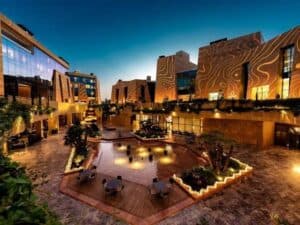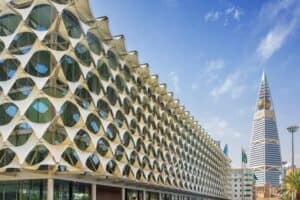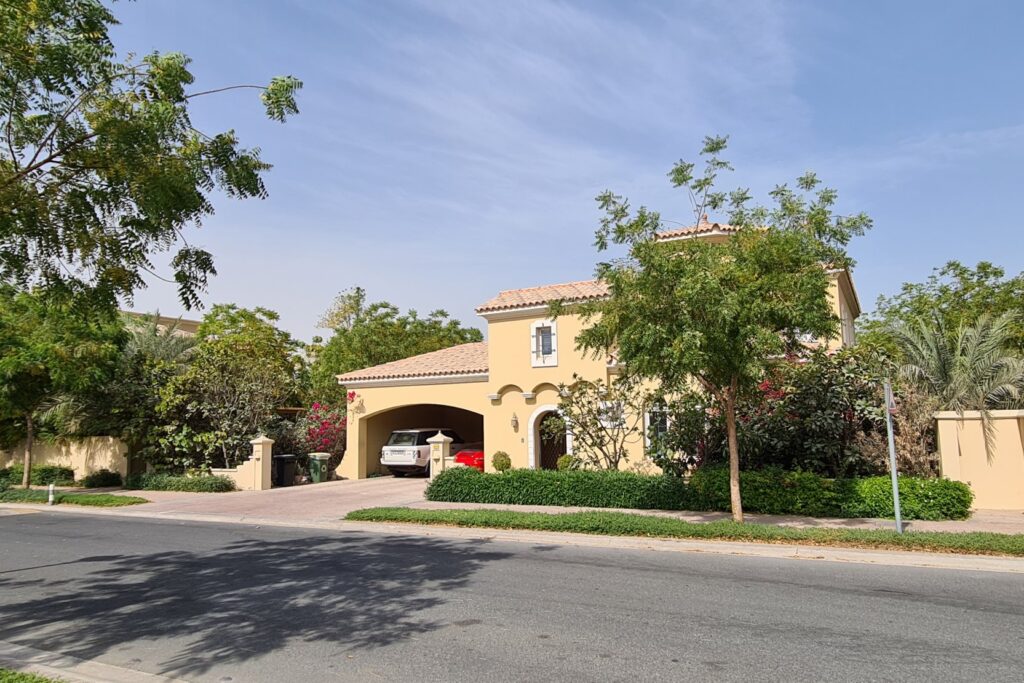Saudi Arabia is a country with cultural heritage that is reflected in its architecture. The architectural styles of Saudi Arabia have evolved by the influence of various factors such as religion, climate, and available resources. From the pre-oil era to modern times, the architecture of Saudi Arabia has undergone significant changes, but it has always maintained its unique identity.
The architecture of Saudi Arabia is a blend of traditional and modern styles, focusing on simplicity, functionality, and sustainability. Traditional architecture in Saudi Arabia uses mud, clay, and stone as building materials, while contemporary architecture utilizes concrete, steel, and glass. The conventional architecture of Saudi Arabia is also influenced by Islamic art and calligraphy, which are often incorporated into the design of buildings.
The architecture of Saudi Arabia is an integral part of the country’s cultural heritage and reflects its people’s values, beliefs, and traditions. The government has many iconic buildings and structures that showcase the unique architecture of Saudi Arabia, ranging from ancient historical sites to modern skyscrapers. In this article, we will explore the different architectural styles of Saudi Arabia and their significance in the country’s cultural heritage.

Historical Overview of Saudi Architectural Evolution
Saudi Arabia has a rich architectural evolution history that spans several centuries. The country’s architectural styles have been shaped by various factors such as religion, culture, and geography. In this section, we will explore the different periods that have influenced the evolution of Saudi architecture.
Pre-Islamic and Early Islamic Periods
The construction of mud-brick and clay characterized the pre-Islamic and early Islamic periods of Saudi architecture. This period was simple and functional, with buildings designed to withstand the harsh desert climate. The most notable structures of this period were the Al-Ula tombs, carved out of sandstone cliffs and dating back to the 1st century BC.
Rise of Islamic Architecture
The rise of Islamic architecture in Saudi Arabia began in the 7th century with the advent of Islam. The architecture of this period was heavily influenced by Islamic design principles, focusing on geometric patterns and calligraphy. The most notable structures of this period were the mosques, designed to serve as centers of worship and community gathering places.
Influence of Ottoman and Persian Styles
The influence of Ottoman and Persian styles on Saudi architecture started back in the 16th century. During this period, the Ottomans and Persians brought their unique architectural styles, characterized by domes, arches, and intricate tile work. These styles incorporate into the existing Saudi architectural styles, resulting in a special blend of traditional and foreign styles.
Overall, the architectural evolution of Saudi Arabia has rich history and diverse cultural influences. From the simple mud-brick structures of the pre-Islamic period to the intricate tile work of the Ottoman and Persian styles, Saudi Arabia’s architectural styles will keep evolving and adapting to the changing needs of its people.
Traditional Architectural Styles
Saudi Arabia is a country with a rich architectural heritage that reflects its diverse cultural and historical influences. Traditional architecture in Saudi Arabia is characterized by using local materials and construction techniques adapted to the harsh desert environment.
Najdi Architecture
Najdi architecture is a traditional style that is prevalent in the central region of Saudi Arabia. It is characterized by its simplicity, symmetry, and use of local materials such as mud, stone, and wood. The most notable feature of Najdi architecture is the use of thick and sturdy mud-brick walls that provide insulation against the extreme temperatures of the desert.
Asir Architecture
Asir architecture is a traditional style prevalent in the southwestern region of Saudi Arabia. It is characterized by its distinctive use of stone and wood, readily available in the region’s mountainous terrain. Asir architecture is known for its intricate wood carvings and decorative motifs, often used to adorn the facades of buildings.
Hejazi Architecture
Hejazi architecture is a traditional style prevalent in the western region of Saudi Arabia. It is characterized by its use of coral stone, which is abundant along the Red Sea coast. Hejazi architecture is known for its ornate facades and intricate geometric patterns, often used to decorate the exteriors of buildings.
In conclusion, traditional architecture in Saudi Arabia reflects the country’s rich cultural and historical heritage. Using local materials and construction techniques has resulted in a unique architectural style adapted to the harsh desert environment.

Architectural Elements and Materials
Its geography, climate, and cultural heritage influence Saudi Arabia’s architectural styles. The country’s architecture reflects its rich history and the diverse civilizations that have contributed to its development. Natural materials such as mud, stone, wood, and coral are used daily in Saudi Arabia’s traditional architecture.
Use of Mud and Adobe
Mud and adobe are among the most commonly used building materials in Saudi Arabia. A mudbrick is a brick made from mud and straw that is dried in the sun. It is used to construct walls, floors, and roofs. Adobe is a brick made from mud and water that is molded into shape and left to dry in the sun. Both materials are readily available in Saudi Arabia and provide good insulation against the hot and dry climate.
Stone and Coral Constructions
Stone and coral are also commonly used building materials in Saudi Arabia. Coral stone is a type of limestone that is made from the skeletons of marine organisms. It is abundant in the Red Sea region and used to construct walls, floors, and roofs. Stone is used for the construction of buildings, walls, and bridges. Using stone and coral gives Saudi Arabia’s architecture a unique character and reflects the country’s close relationship with the sea.
Wood and Mashrabiya
Wood is another essential building material in Saudi Arabia’s traditional architecture. It is used for the construction of doors, windows, and roofs. Mashrabiya is a type of wooden lattice screen that provides privacy and shade. It is a characteristic feature of Saudi Arabia’s architecture and is often used in constructing balconies and windows.
In conclusion, Saudi Arabia’s architecture reflects its rich cultural heritage and the diverse civilizations that have contributed to its development. Using natural materials such as mud, stone, wood, and coral makes Saudi Arabia’s architecture unique and reflects the country’s close relationship with the sea and desert.
Cultural and Environmental Influences
The country’s culture and environment heavily influence the architectural styles of Saudi Arabia. Various factors, including religion, traditions, natural resources, and climate, have shaped the country’s heritage.
Climatic Adaptation in Design
The desert climate of Saudi Arabia is hot and arid, with temperatures often exceeding 100 degrees Fahrenheit during the day and dropping significantly at night. As a result, traditional Saudi Arabian buildings are designed to provide natural ventilation and keep the interior cool during the day. The use of thick walls and small windows helps to keep the heat out, while open courtyards and wind towers allow for natural ventilation.
Courtyard and Open Spaces
Courtyards and open spaces are an essential feature of traditional Saudi Arabian architecture. The courtyard is typically the central feature of a building, and it serves as a gathering place for family and friends. Courtyards also provide natural light and ventilation, which is especially important in a hot and arid climate like Saudi Arabia.
Religious and Social Considerations
Religion is significant in Saudi Arabian culture, influencing the country’s architectural styles. Mosques, for example, are designed to be the focal point of a community and are typically located at the center of a town or village. Using domes and minarets is also daily in Saudi Arabian architecture and reflects the country’s Islamic heritage.
In addition to religious considerations, social factors have also influenced the architectural styles of Saudi Arabia. Family and community are highly valued in Saudi Arabian culture, and buildings are often designed to accommodate large families and provide communal spaces for gathering and socializing.
Overall, the architectural styles of Saudi Arabia are a reflection of the country’s culture and environment. The use of natural ventilation, open spaces, and courtyards, as well as the incorporation of religious and social considerations, has resulted in a unique and distinctive architectural style that is both functional and aesthetically pleasing.
Modern and Contemporary Architecture
Saudi Arabia has undergone a significant architectural transformation since the post-oil boom urban development. The country has transitioned from traditional design to modern and contemporary architectural styles. Incorporating tradition with modernity has been a critical factor in developing contemporary architecture in Saudi Arabia.
Post-Oil Boom Urban Development
The oil boom in Saudi Arabia led to a rapid urbanization process. The country witnessed an influx of people, which required the construction of modern and contemporary buildings. The government invested heavily in urban planning and modern infrastructure. Modernizing the country’s infrastructure led to the development of contemporary architecture in Saudi Arabia.
Incorporating Tradition with Modernity
Saudi Arabia’s modern architecture style incorporates traditional elements with contemporary design. The architects of the 1970s and 80s tried to develop approaches and how those approaches could relate to their local context. This approach has created unique buildings that reflect the country’s identity while embracing modernity.
Skyscrapers and Urban Skyline
Skyscrapers and an urban skyline characterize Saudi Arabia’s modern architectural style. The country has some of the tallest buildings in the world, including the Abraj Al Bait Clock Tower, which stands at 601 meters. The country’s urban skyline has transformed significantly in recent years, with the construction of modern buildings that reflect the country’s identity.
Innovation has been a critical factor in the development of modern architecture in Saudi Arabia. The country has embraced modern technology and construction methods, which have led to the development of unique buildings that reflect the country’s identity. The incorporation of tradition with modernity has been a critical factor in the development of modern architecture in Saudi Arabia.

Key Architectural Landmarks
Saudi Arabia is home to diverse architectural styles that reflect the country’s rich cultural heritage and modern innovation. From historical landmarks to modern skyscrapers and cultural buildings, Saudi Arabia has much to offer regarding architectural landmarks.
Historical Landmarks and UNESCO Sites
Saudi Arabia has several historical landmarks and UNESCO sites that showcase the country’s rich cultural heritage. One such landmark is the Masmak Fortress in Riyadh, which dates back to the 19th century and played a main role in the country’s history.
Another UNESCO site is the historic city of Diriyah, the birthplace of the first Saudi state and home to several historical buildings and sites. The city’s architecture reflects the Najdi style, characterized by its use of mud and clay.
Modern Skyscrapers and Towers
Saudi Arabia is also home to several modern skyscrapers and towers that showcase the country’s modern innovation. The Kingdom Centre Tower in Riyadh is one such landmark. It is the third tallest skyscraper in the country and features a unique design inspired by traditional Islamic architecture.
The Abraj Al Bait Towers in Mecca is another example of modern architecture in Saudi Arabia, home to the world’s most enormous clock face and several luxury hotels.

Cultural and Educational Buildings
Saudi Arabia is also home to several cultural and educational buildings that showcase the country’s commitment to education and culture. The Ithra complex in Dhahran is one such landmark. The cultural center features a library, museum, and theater.
Another example of a cultural structure in Saudi Arabia is the King Abdulaziz Center for World Culture in Dhahran, which has a number of galleries and exhibition areas that highlight the nation’s cultural legacy.
In conclusion, Saudi Arabia’s architectural landmarks showcase the country’s rich cultural heritage and modern innovation. From historical landmarks to modern skyscrapers and cultural buildings, Saudi Arabia has much to offer regarding architectural landmarks.
Sustainability and Future Initiatives
Green Building and Environmental Stewardship
Saudi Arabia has made significant strides in sustainable architecture and environmental stewardship in recent years. The country’s commitment to green building practices is evident in projects such as the “Green Riyadh” initiative, which aims to plant 7.5 million trees across the city within parks, gardens, schools, healthcare, and public facilities. Furthermore, the Saudi Green Initiative (SGI), as Crown Prince Mohammed bin Salman bin Abdulaziz introduced it in 2021, is a comprehensive social program aimed at halting climate change, enhancing living standards, and safeguarding the environment for coming generations.
Leading architecture firms in Saudi Arabia, such as Omrania, have established a reputation for excellence in blending aesthetic and functional design, setting a benchmark for sustainable architecture in the Arab Peninsula. Creating a more sustainable built environment is the responsibility of these businesses, which emphasize energy efficiency, green building materials, and sustainable construction processes.
Saudi Vision 2030 and Urban Projects
Saudi Arabia’s Vision 2030 is a visionary catalyst, propelling the nation towards a future where architecture harmonizes with innovation and sustainability. Ambitious projects, such as Qiddiya, a 334-square-kilometer entertainment city, showcase a commitment to pushing the boundaries of architectural design. The city will work on renewable energy and will feature a range of sustainable design elements, such as green roof, rainwater harvesting, and energy-efficient lighting.
In addition to Qiddiya, Saudi Arabia invests in urban development projects prioritizing sustainability and innovation. The King Salman Energy Park (SPARK) is a prime example of this, focusing on energy efficiency, renewable energy, and sustainable water management. These projects demonstrate Saudi Arabia’s commitment to creating a more sustainable future for its citizens and the world.
Saudi MLS
In the dynamic world of real estate, Saudi MLS serves as the vital compass, directing professionals through the complexities of emerging brokerages, cultivating essential connections with potential clients, and broadening their professional horizons. Saudi MLS is the cornerstone of success within this expansive realm of opportunities. Embark on a journey through its diverse services and pave your way to triumph.

Frequently Asked Questions
What are the defining characteristics of traditional Saudi Arabian architecture?
Traditional Saudi Arabian architecture is known for its simplicity and functionality. The use of mud brick and wood in construction due to the abundance of these materials and geometric patterns, calligraphy, and ornamentation also characterize the architecture. Traditional houses in Saudi Arabia are around a central courtyard, with rooms and living spaces around it.
How has modern architecture in Saudi Arabia integrated with traditional styles?
Modern architecture in Saudi Arabia integrates traditional styles by incorporating traditional design elements into contemporary buildings. This uses geometric patterns, calligraphy, and ornamentation in modern buildings. Some architects have also used traditional materials such as mud brick designs.
What are some notable examples of Najdi architectural design?
Najdi’s architectural design has mud brick and its simple and functional design. The Masmak Fortress in Riyadh is a notable example of Najdi architecture. The fortress was there in the mid-19th century and is now a museum that showcases the history and culture of Saudi Arabia.
How does the architecture of Jeddah reflect the city’s cultural history?
The architecture of Jeddah reflects the city’s cultural history through its use of coral stone and intricate wooden balconies. The city’s historic district, Al-Balad, is home to many preserved and restored traditional houses and buildings. The district also has its souks, markets, and conventional buildings.
Can you describe the influence of Islamic art on the architectural landscape of Saudi Arabia?
Islamic art has had a significant influence on the architectural landscape of Saudi Arabia. Islamic design elements such as calligraphy, geometric patterns, and ornamentation is in many traditional and modern buildings. These elements are a way of expressing the Islamic faith and culture.
What are some key features of Salmani architecture?
Salmani architecture has modern design elements and its focus on sustainability and environmental awareness. The King Abdullah Financial District in Riyadh is a notable example of Salmani architecture. The district features modern skyscrapers incorporating sustainable design features such as solar panels.












